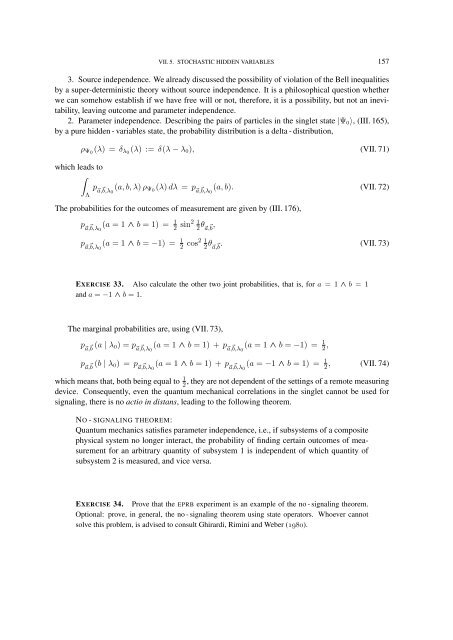FOUNDATIONS OF QUANTUM MECHANICS
FOUNDATIONS OF QUANTUM MECHANICS
FOUNDATIONS OF QUANTUM MECHANICS
You also want an ePaper? Increase the reach of your titles
YUMPU automatically turns print PDFs into web optimized ePapers that Google loves.
VII. 5. STOCHASTIC HIDDEN VARIABLES 157<br />
3. Source independence. We already discussed the possibility of violation of the Bell inequalities<br />
by a super-deterministic theory without source independence. It is a philosophical question whether<br />
we can somehow establish if we have free will or not, therefore, it is a possibility, but not an inevitability,<br />
leaving outcome and parameter independence.<br />
2. Parameter independence. Describing the pairs of particles in the singlet state |Ψ 0 ⟩, (III. 165),<br />
by a pure hidden - variables state, the probability distribution is a delta - distribution,<br />
ρ Ψ0 (λ) = δ λ0 (λ) := δ(λ − λ 0 ), (VII. 71)<br />
which leads to<br />
∫<br />
p ⃗a, ⃗ b,λ0<br />
(a, b, λ) ρ Ψ0 (λ) dλ = p ⃗a, ⃗ b,λ0<br />
(a, b). (VII. 72)<br />
Λ<br />
The probabilities for the outcomes of measurement are given by (III. 176),<br />
p ⃗a, ⃗ b,λ0<br />
(a = 1 ∧ b = 1) = 1 2 sin2 1 2 θ ⃗a, ⃗ b ,<br />
p ⃗a, ⃗ b,λ0<br />
(a = 1 ∧ b = −1) = 1 2 cos2 1 2 θ ⃗a, ⃗ . (VII. 73)<br />
b<br />
EXERCISE 33. Also calculate the other two joint probabilities, that is, for a = 1 ∧ b = 1<br />
and a = −1 ∧ b = 1.<br />
The marginal probabilities are, using (VII. 73),<br />
p ⃗a, ⃗ b<br />
(a | λ 0 ) = p ⃗a, ⃗ b,λ0<br />
(a = 1 ∧ b = 1) + p ⃗a, ⃗ b,λ0<br />
(a = 1 ∧ b = −1) = 1 2 ,<br />
p ⃗a, ⃗ b<br />
(b | λ 0 ) = p ⃗a, ⃗ b,λ0<br />
(a = 1 ∧ b = 1) + p ⃗a, ⃗ b,λ0<br />
(a = −1 ∧ b = 1) = 1 2<br />
, (VII. 74)<br />
which means that, both being equal to 1 2<br />
, they are not dependent of the settings of a remote measuring<br />
device. Consequently, even the quantum mechanical correlations in the singlet cannot be used for<br />
signaling, there is no actio in distans, leading to the following theorem.<br />
NO - SIGNALING THEOREM:<br />
Quantum mechanics satisfies parameter independence, i.e., if subsystems of a composite<br />
physical system no longer interact, the probability of finding certain outcomes of measurement<br />
for an arbitrary quantity of subsystem 1 is independent of which quantity of<br />
subsystem 2 is measured, and vice versa.<br />
EXERCISE 34. Prove that the EPRB experiment is an example of the no - signaling theorem.<br />
Optional: prove, in general, the no - signaling theorem using state operators. Whoever cannot<br />
solve this problem, is advised to consult Ghirardi, Rimini and Weber (1980).
















